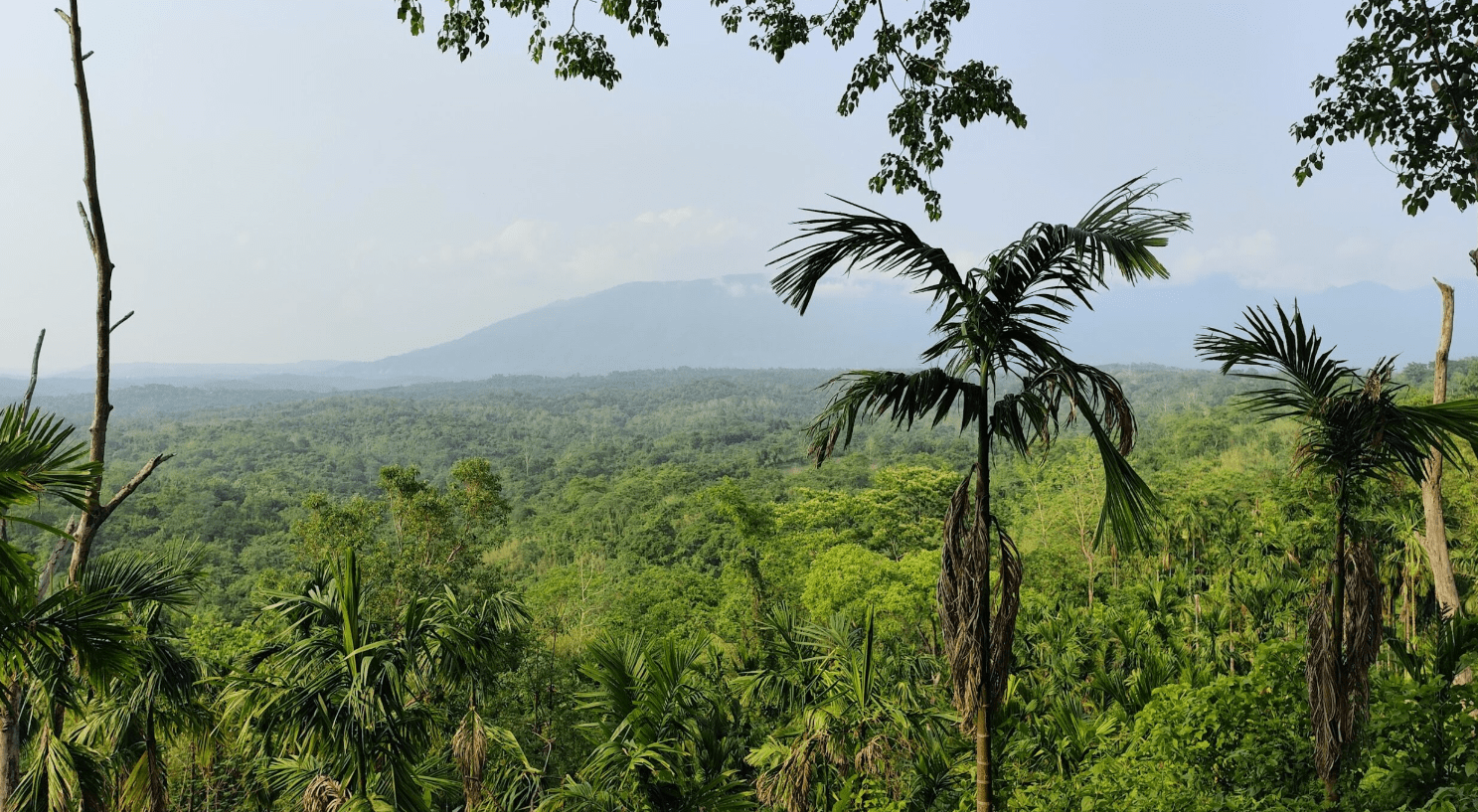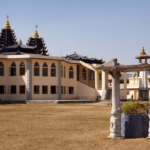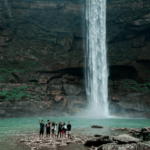Garo Hills had been on my travel list for quite some time. I finally had the chance to visit when I was in Shillong for the 2nd Shillong Cherry Blossom Festival in 2017. During my stay, a stall owner at the festival, who was from Garo Hills, mentioned a festival happening in her region. Intrigued by the idea of experiencing another festival in Meghalaya, I decided on a spur-of-the-moment trip to Tura.
Although I encountered some skepticism about traveling alone as a female, especially given the reports of insurgencies in the area, I chose to proceed with my plan to attend the Wangala Festival in Garo Hills. I took a night bus from Shillong to Tura.
I’m grateful I went through with it. I immediately fell for the charm of the region and its people. It was at that moment I resolved to return to Garo Hills, this time with Agni. It took nearly five years, but we eventually made our second trip to Garo Hills.
Garo Hills: The Land of the A•chiks
Situated in the western region of Meghalaya, Garo Hills boasts lush green forests. It is home to a notable population of Hoolock Gibbons, which we had previously seen at Hoollongapar Wildlife Sanctuary in Assam. The area features waterfalls, caves, and serene natural beauty.
Garo Hills also hosts Citrus Indica, the Indian Wild Orange, known as one of the most ancient citrus fruits. The National Citrus Gene Sanctuary resides within the Nokrek Biosphere Reserve.
But the highlight is the Garo people, who refer to themselves as A•chiks. They are among the friendliest people I’ve met, always welcoming with smiles. The Garos practice a matrilineal system, where clan names and property are inherited through the youngest daughter. Like other Meghalaya tribes, they maintain a close bond with nature.
With so much to explore, Garo Hills is a true gem for visitors. I hope this guide helps you plan a trip to this lesser-known region of Northeast India.
Location of Garo Hills
Garo Hills is located in the western part of Meghalaya, bordering the Khasi Hills and Assam. It comprises several districts: East Garo Hills (headquartered in Williamnagar), West Garo Hills (Tura), North Garo Hills (Resubelpara), South Garo Hills (Baghmara), and South West Garo Hills (Ampati).
How to Reach Garo Hills
Garo Hills can be accessed from Shillong or Guwahati. The nearest airport is in Guwahati, about 200 km from Tura, the largest town in the region.
Typically, trips to Garo Hills are based in Tura. Travel from Guwahati is generally easier, with local buses available from Shillong’s Polo Ground bus stand and Guwahati’s Paltan Bazar and ISBT bus stands. Car rentals from either city are also an option.
During my 2017 visit, I traveled by bus from Shillong to Tura, a route that passed through Guwahati due to poor road conditions. On our recent visit, however, the roads have improved significantly, making the journey from Shillong to Tura via Mairang and Nongstoin much smoother and faster.
Places to Visit in Garo Hills
Garo Hill covers a vast area, with each district offering unique attractions. Here are some notable spots to explore:
- Tura Peak
Located about 4 km east of Tura Town, Tura Peak stands at 872 meters above sea level. It’s a paradise for nature and bird enthusiasts, with hornbills and gibbons in its forests. The trek to Tura Peak is moderate and takes around an hour to ninety minutes. A morning hike is recommended for bird sightings. From the peak’s watchtower, you can enjoy panoramic views of Tura town, surrounding valleys, and the Jinjiram River. - Nokrek National Park
At 1412 meters, Nokrek Peak is the highest point in Garo Hills. About 40 km from Tura, it was designated a Biosphere Reserve in 2009 and is a biodiversity hotspot. Home to the elusive red panda, as well as Asiatic Wild Elephants, marbled cats, and clouded leopards, Nokrek also attracts birdwatchers with its migratory and rare species. While tourists can’t enter the core area, the surrounding reserve and Nokrek Peak trek are accessible. Daribokgre village is the starting point for the trek. - Pelga Waterfalls
Situated around 7 km from Tura town, Pelga Falls is a popular spot for angling and nature lovers. The waterfall is most impressive during the monsoon, and locals often fish in the pool at its base. - Rongbangdare Waterfall
About 37 km from Tura, Rongbangdare Waterfall is nestled among emerald green hills. The hike to the top of the waterfall can be challenging but rewarding, with stunning views. - Chandigre Village
Located at the base of Nokrek Biosphere Reserve, Chandigre serves as a base for the Nokrek Peak trek. The resort here, run by the local Garo people, features traditional architecture and accommodations. Visitors can explore the village, taste Garo cuisine, and visit a local brewery. - Chibragre
A tranquil picnic spot where the Rongram and Gangol rivers converge, Chibragre offers a peaceful setting surrounded by greenery. Though primarily known to locals, it’s a serene spot for visitors. - Balpakram National Park
Located in the far south of Garo Hills, Balpakram is known for its folklore and diverse wildlife. The park’s landscape includes the Simsang River and local waterfalls, with dramatic canyon views from the plateau top. - Siju Cave and Siju Wildlife Sanctuary
About 30 km from Baghmara, Siju Cave is one of the longest in Meghalaya and is known for its bat colonies. The cave features intricate limestone formations and requires a torch or headlamp for exploration. Nearby Siju Wildlife Sanctuary is home to migratory birds and primates. - Wari Chora
A newly popular destination for adventure tourism, Wari Chora in South Garo Hills offers rafting and canoeing on the Rongdik River within narrow gorges. Access involves off-roading and a trek from Emnagre village. - Fish Sanctuaries
Several fish sanctuaries across Garo Hill aim to protect indigenous fish species. Notable sanctuaries include Rombagre and Jadisil.
Festivals of the Garos
The Wangala Festival is the most significant festival of the Garos, celebrating the harvest with a tribute to the “Great Giver.” Held annually in November, the festival features vibrant dances performed by groups of 30 dancers and 10 drummers, with 10 such groups performing, making it known as the 100 Drums Wangala Festival.
Garo Hills Travel Guide (FAQs Answered)
Is it safe to travel to Garo Hills?
Yes, Garo Hills is generally safe for tourists. The local Garos are incredibly friendly and helpful. While political disturbances are a thing of the past, it’s wise to stay aware and follow local advice.
How to Reach Garo Hills?
It can be reached from Guwahati or Shillong. The nearest airport is Guwahati, and local buses or cabs can be hired to Tura, the major town.
Where to Stay in Garo Hills?
Hotels and guesthouses are available in towns like Tura, Williamnagar, and Baghmara, as well as homestays in various villages.
How are the Road Conditions in Garo Hills?
Road conditions have improved significantly, though some areas near Siju and Balpakram may still have rough patches.
How to Plan a Trip to Garo Hills?
A 6-7 day trip is sufficient to explore the main attractions. Local transport is available but not frequent, so basing your stay in Tura is advisable. Local tour operators can assist with planning.
What is the Best Time to Visit Garo Hills?
The best time to visit is between November and March, when the weather is ideal for outdoor activities. Summers can be hot and humid, making travel less comfortable.


